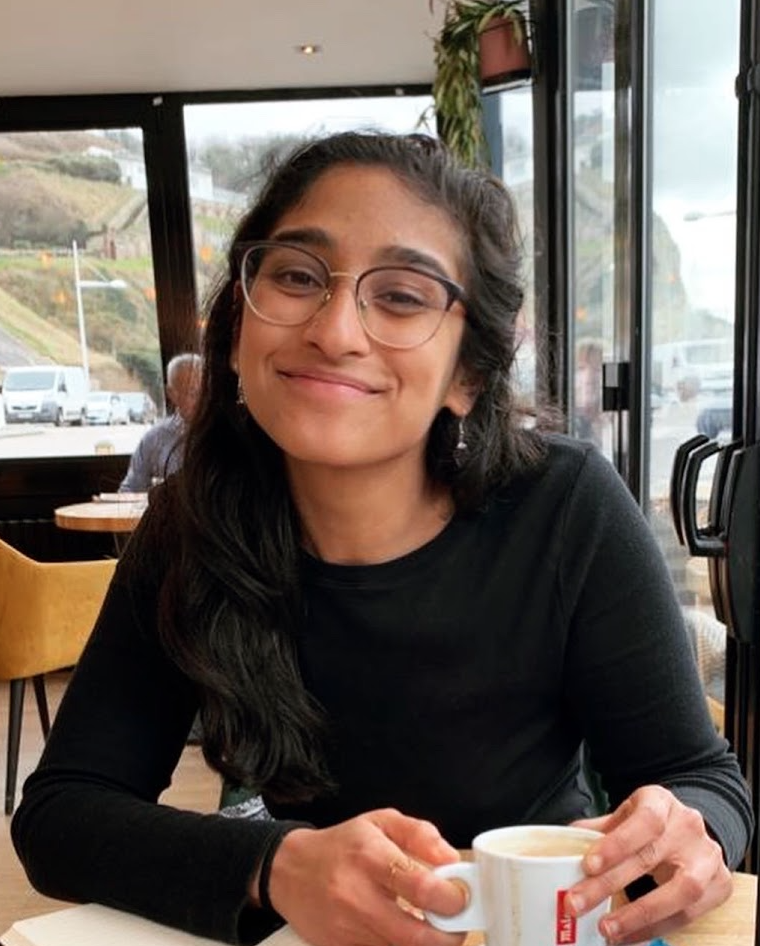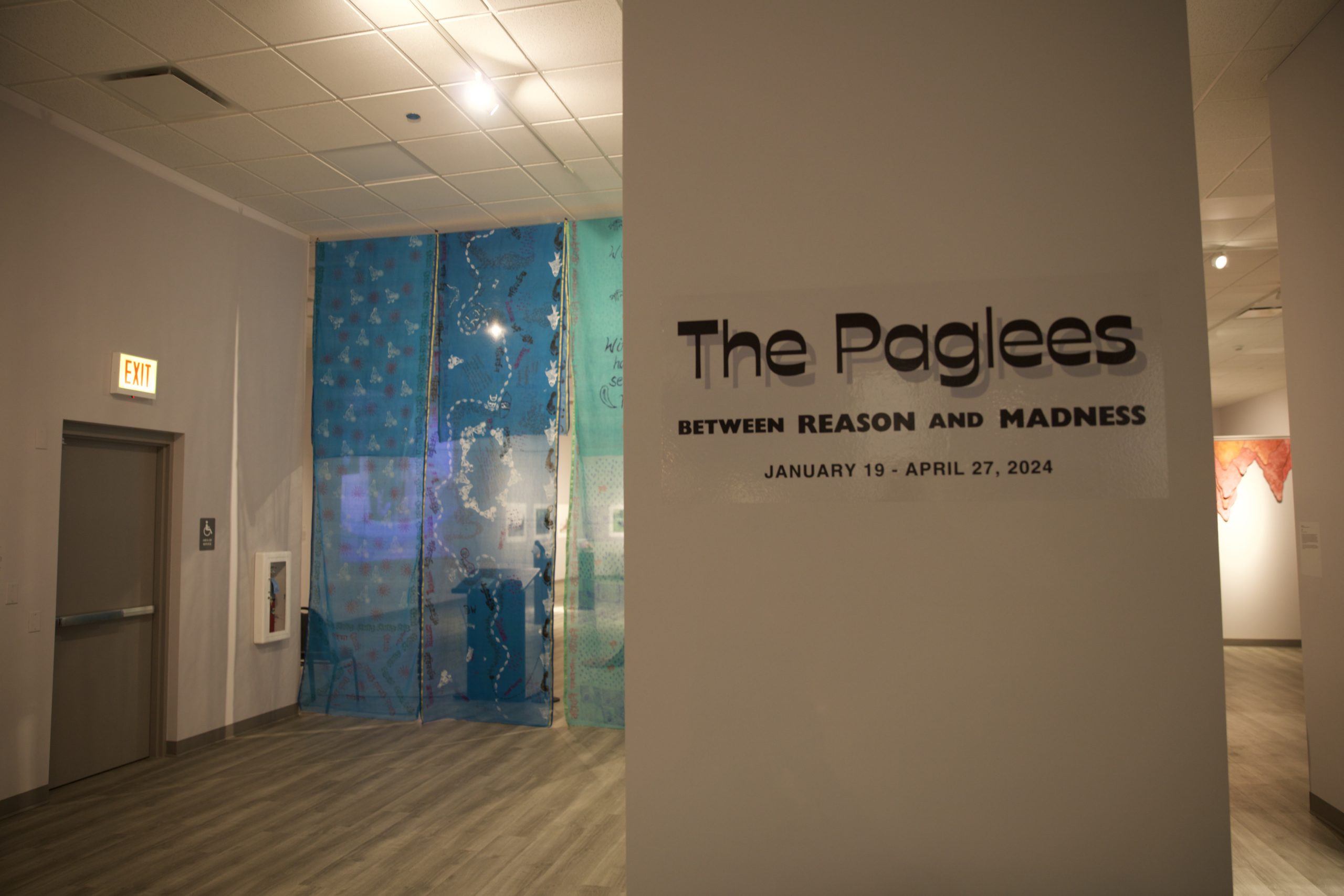Paglee is a slippery word, and one that I’ve been attached to since childhood—it is the feminine form in many South Asian languages for “crazy person,” and its connotations are highly context-dependent. While it can be derogatory or a term of affection for a rowdy child (as it was for me), it transforms into something dismissive in adulthood (akin to how women have historically been written off casually as ‘hysterical’ or ‘deviant’). In my mind, paglee has occupied a place within conversation to denote unruliness, a way of pointing out when one’s behavior moves past the realm of “reasonable.” The curators and artists of the newly formed collective, The Paglees, reclaim the label by celebrating the loosely translated “madwoman” who is outside of logic and control. A throughline of the exhibition calls to mind Saidiya Hartman’s notion of “waywardness,” which is described as “a practice of possibility at a time when all roads, except the ones created by smashing out, are foreclosed.” When suffocating under an imposed framework, the paglee has no choice but to embrace waywardness in pursuit of liberation. The Paglees are a group of feminist artists who challenge the socio-political norms and patriarchal values that dictate the line between ‘reason’ and ‘madness.’ The seven self-identified paglees, whose work is currently on view at the South Asia Institute, are Shelly Bahl, Monica Jahan Bose, Fawzia Khan, Renluka Maharaj, Indrani Nayar-Gall, Nirmal Raja, and Pallavi Sharma.
Milwaukee-based Nirmal Raja’s series Contained I-IV especially brings out themes of confinement and resistance. Raja’s installation consists of four battered, discolored plaster boxes with ornate saris (traditional South Asian garment wraps, typically nine yards of cloth) bursting out at various angles. It seems as though they were shoved into a container far too small, and after a violent struggle, the saris fought their way out of captivity. Raja mentions that this was conceived of in the aftermath of the 2016 election when Islamophobia affected her daily existence in Wisconsin, adding further significance to the initial whiteness of the box, visible underneath the blackening collagraphy. As an immigrant woman of color in America, Raja’s lived experience is doubly marginalized by patriarchal demands and white supremacist projections. Looking at these pieces, one can feel the choking impact of these power structures, as well as the cathartic rupture of breaking free.
Raja’s conceptual engagement with the sari continues in a back corner of the gallery, in her works Entangled (2015) and the partnered photo series The Weight of Our Past (2021). Entangled is a soft sculpture made entirely of silk saris collected from the wardrobes of other Indian-American women. The colorful and ornate saris in this work signal conventions of South Asian femininity and domesticity. While these garments are beautiful on their own, their elegance is transformed into a heavy, twisted shape, with its placement almost giving the appearance of a body slumped over in exhaustion. The Weight of Our Past, in the background, is a photo series that depicts the artist dragging a similar piece across rough terrains. The sense of being encumbered by excess baggage, and the Sisyphean responsibility of dragging it everywhere speaks to the notion of Indian women being burdened with carrying ‘traditional femininity’ as they move through the world. Another component to the work is a QR code that leads to audio recordings of interviews with the women whose saris are used in the piece. The multi-pronged approach by Raja investigating the pressures of conventional womanhood on the diaspora moves seamlessly across three mediums, creating cohesion along with nuance.
Other artists deploy the sari in different ways. Monica Jahan Bose, for example, focuses on the ongoing effects of extractive capitalism on her ancestral village in Bangladesh. Her ecofeminist approach appears in paintings and woodblock prints adorning plain saris with climate justice-oriented images and words (i.e. bicycles, the Bengali words for environmental elements, the Capitol building, etc.). Some pieces by Bose hang as full-length saris, and others are transformed into kanthas, the result of a common process in which saris are cut up and re-layered into thicker square cloths. Kanthas are then used for decoration, or as small blankets and swaddles for babies. These modes of sustainability and repurposing starkly contrast the relationship with clothes and fabric in Western consumerist cultures of fast fashion, often mass-produced in Bangladeshi factories not far from these villages themselves.
Along with highlighting the transnational economic forces impacting South Asian women through capitalism, a standout aspect of Between Reason and Madness is the caste and race-conscious nature of the work. In Charlotte-based Indrani Nayar-Gall’s Words (2017-2019), a T-shaped PVC pipe stands on the floor with canvas forms flowing symmetrically out of it. The canvases contain phrases that have been used against Black women in the United States one side (“out of control,” among others) and Dalit women subjugated in India on the other such as excerpts from casteist Hindu texts like the Manusmriti. This piece meaningfully engages with politics of misogyny as they manifest parallelly on both sides of the artist’s migratory trajectory from Kolkata to North Carolina.
While systems of oppression are culturally specific (as acknowledged by the distinct sets of words on each side of the sculpture), their impacts on the lives of women are mirrored in many ways. This piece shows us the shared elements affecting these demographics without erasing their differences. While the histories of antiblackness and casteism cannot be conflated, recognizing the similarities in their manifestations today allows us to imagine new kinds of solidarity. Interestingly, the structural concept of something spilling out from a rigid white structure (here, the PVC pipe), aligns with that of Raja’s Contained, where fabric bursts out from white plaster. This common denominator in theme—a focus on emancipation from existing frameworks—speaks to the overall rebellious, ungovernable nature of being a paglee.
Another component that I particularly appreciate is how the show extends beyond contemporary issues to address South Asian womanhood longitudinally. Renluka Maharaj, who has roots in Trinidad and Tobago, draws on her family’s history in the Caribbean as indentured servants trafficked across the British Empire to replace slave labor following abolition in the 19th century. Her pieces are the result of meticulous archival research and an intricate layering of artifacts with Maharaj’s own patterns, colors and textures. In the archives were antique postcards picturing exoticized Indo-Caribbean women to encourage tourism from Europe, stamped with reductive and dehumanizing labels like “Coolie Woman” or “Coolie Belle.” In Maharaj’s work, by contrast, many vintage photographs are named for the specific subjects of the portraits—Jiya with Her Daughter Ira (2022), or Kavi with Little Anju (2022)—how one might label photos in a family album. Giving a sense of intimacy and familiarity to these moments from the daily lives of indentured women, Maharaj uses glimpses of their existence in the archives not predicated on racialization or enslavement to restore their individuality.
Nearby, New York-based Shelly Bahl adds a more playful, interactive installation to the mix. Sisters of Shakti (2021-ongoing) is a speculative cult (complete with an Instagram account) advertised as a utopian “residential community for women.” The advertisements call to mind common trends of white women appropriating ancient South Asian traditions like yoga or Hindu prayer mantras, and enveloping them into pseudo-spiritual alternative lifestyles. The installation is set up like a tabling informational booth one might see at a festival, with unsettling AI-produced images of white women doing yoga poses on banners beside the table. The trios of women on these advertisements look unremarkable from a distance, but upon closer examination, their faces are all slightly distorted and monstrous. When the artist is present, the work takes on an additional performance aspect, as Bahl sits at the table and encourages passers-by to join the community, handing out business cards and promising to alleviate the woes and anxieties of the modern world. This tongue-in-cheek installation is not only well designed, but also balances out the heaviness of many surrounding installations while still making sharp commentary on the disturbing nature of subsuming South Asian culture into white feminism.
While at first it can be overwhelming to encounter the voices of so many artists and media, the themes and installations create an unexpected harmony. Named for reclaiming the space of madness, The Paglees imagine a selfhood outside patriarchal bounds of what is ‘reasonable.’ Returning to Hartman, waywardness is “an ongoing exploration of what might be; an improvisation within the terms of social existence, when the terms have already been dictated.” In a social landscape where the South Asian diaspora (and women in particular) are often expected to preserve and carry on tradition, The Paglees intervene and encourage us to push past existing constructions of South Asian womanhood through an intersectional feminist lens, dissolving the eponymous line “between reason and madness.”
The Paglees: Between Reason and Madness is on display at the South Asia Institute (1925 S Michigan Ave, Chicago) from January 19 to April 27, 2024. It features the following artists: Fawzia Khan, Indrani Nayar-Gall, Monica Jahan Bose, Nirmal Raja, Pallavi Sharma, Renluka Maharaj, and Shelly Bahl.

About the author: Mrittika Ghosh (she/her) is a Bengali-American reader, writer, and translator currently based in Chicago. She holds a BA from Mount Holyoke College and an MA from the University of Chicago. She has also been a bookseller, oral historian, and educator. Her writing focuses on queerness, migration, and postcolonial art in Francophone and South Asian diasporic contexts.






